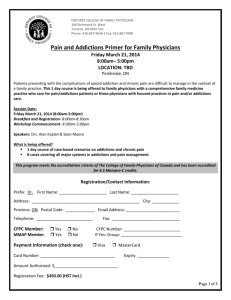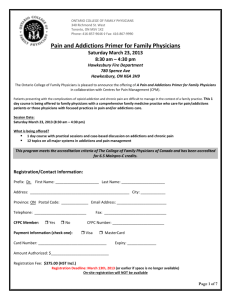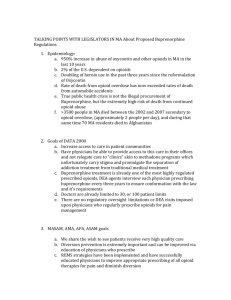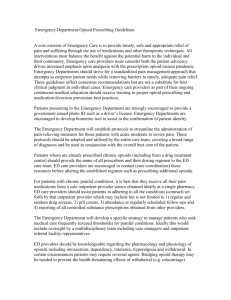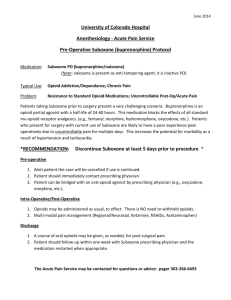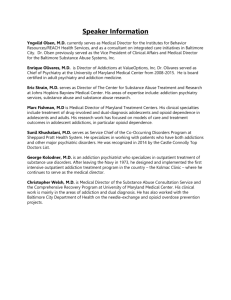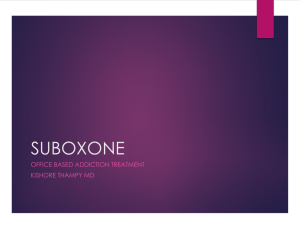Emergency Medicine Primer for Family Physicians
advertisement
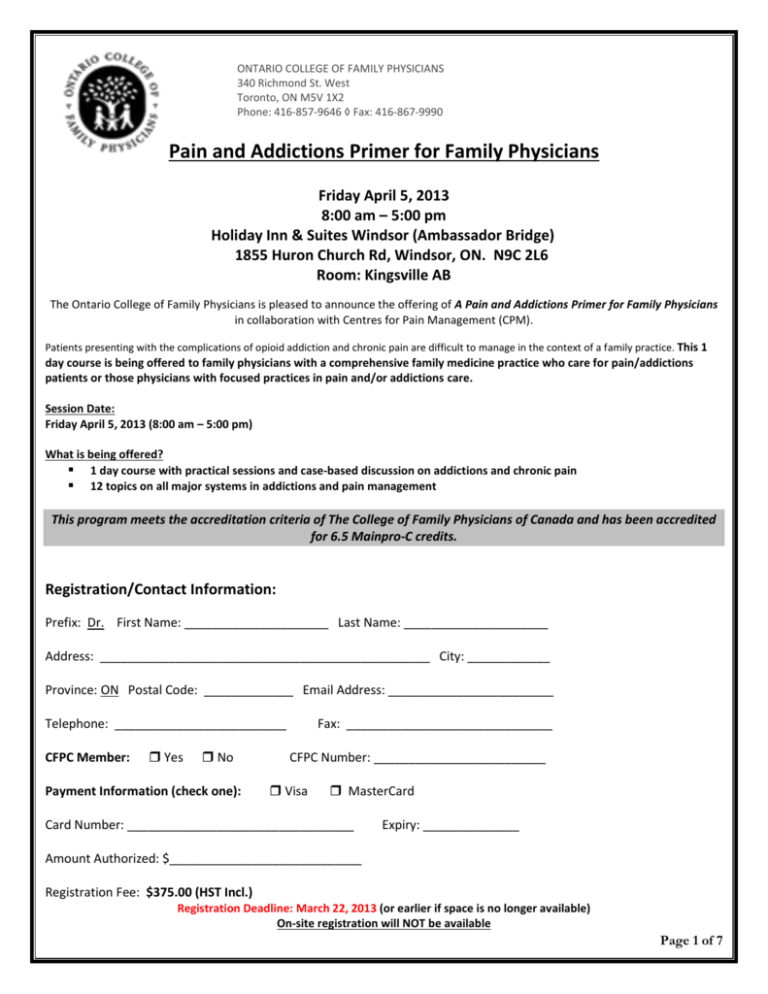
ONTARIO COLLEGE OF FAMILY PHYSICIANS 340 Richmond St. West Toronto, ON M5V 1X2 Phone: 416-857-9646 ◊ Fax: 416-867-9990 Pain and Addictions Primer for Family Physicians Friday April 5, 2013 8:00 am – 5:00 pm Holiday Inn & Suites Windsor (Ambassador Bridge) 1855 Huron Church Rd, Windsor, ON. N9C 2L6 Room: Kingsville AB The Ontario College of Family Physicians is pleased to announce the offering of A Pain and Addictions Primer for Family Physicians in collaboration with Centres for Pain Management (CPM). Patients presenting with the complications of opioid addiction and chronic pain are difficult to manage in the context of a family practice. This 1 day course is being offered to family physicians with a comprehensive family medicine practice who care for pain/addictions patients or those physicians with focused practices in pain and/or addictions care. Session Date: Friday April 5, 2013 (8:00 am – 5:00 pm) What is being offered? 1 day course with practical sessions and case-based discussion on addictions and chronic pain 12 topics on all major systems in addictions and pain management This program meets the accreditation criteria of The College of Family Physicians of Canada and has been accredited for 6.5 Mainpro-C credits. Registration/Contact Information: Prefix: Dr. First Name: _____________________ Last Name: _____________________ Address: ________________________________________________ City: ____________ Province: ON Postal Code: _____________ Email Address: ________________________ Telephone: _________________________ CFPC Member: Yes No Payment Information (check one): Fax: ______________________________ CFPC Number: _________________________ Visa MasterCard Card Number: _________________________________ Expiry: ______________ Amount Authorized: $____________________________ Registration Fee: $375.00 (HST Incl.) Registration Deadline: March 22, 2013 (or earlier if space is no longer available) On-site registration will NOT be available Page 1 of 7 The OCFP reserves the right to cancel sessions due to unforeseen circumstances or insufficient advance registration. In the event of a cancellation made by the OCFP, a full refund will be given to the registrants. However, the OCFP cannot accept responsibility for out-of-pocket expenses due to cancellation of a session. Cancellations made by March 27th will be refunded, less a 20% administrative fee. Please address completed Registration Form to: Ontario College of Family Physicians 340 Richmond Street West, Toronto, ON, M5V 1X2 Attention: Arsela Hoxhaj Tel: 416-867-9646 ext. 20 Fax: 416-867-9990 arsela@cfpc.ca A confirmation email will be sent within 2 business days of receiving your registration. If you do not receive confirmation, please contact us. To better assess your needs and experience, please use the following link to access our questionnaire. If you prefer to provide us with your answers in a written format, please complete the following forms and fax documents to 416867-9990. Pre-Course Assessment Questionnaire: https://www.surveymonkey.com/s/VG6TCY5 ALL following questions must be completed (incomplete forms will not be processed). Please note that any information you provide will be kept confidential and will only be reported in grouped form: 1. Current Status: Family Physician Focused Practice Physician TYPE OF PRACTICE a. b. c. d. Full-Time Solo Office Urban Part-Time Group Hospital Suburban Both Both Rural 2. How did you hear about the Pain and Addictions Primer for Family Physicians? _____________________________________________________________ 3. How many years of experience do you have in managing pain/addictions patients? _______________________________________________________________ 4. How would you rate your comfort level in prescribing opioids? Poor Fair Good Very Good Excellent 1 2 3 4 5 5. How would you rate your current level of confidence in your ability to manage chronic pain? Not Confident Slightly Confident Fairly Confident Quite Confident Very Confident 1 2 3 4 5 Page 2 of 7 6. In the past six months, how many patients have you prescribed opioids for chronic non-cancer pain? Please circle your option 0 1-5 6-10 11-15 16-20 21 or more 7. In the past six months, for how many patients on long-term opioids have you ordered a urine drug screen? Please circle your option 0 1-2 3-4 5-6 7-8 9 or more 8. In the past six months, for how many patients on long-term opioids have you decreased (tapered) the opioid dose? Please circle your option 0 1-2 3-4 5-6 7-8 9 or more 9. In the past six months, for how many patients on long-term opioids have you increased the frequency of dispensing (eg from once every month to once every week)? Please circle your option 0 1-2 3-4 5-6 7-8 9 or more 10. In the past six months, for how many patients on long-term opioids have you referred the patient to an addiction program (methadone or buprenorphine?) Please circle your option 0 1-2 3-4 5-6 7-8 9 or more Page 3 of 7 11. Based on the course outline listed below, do you see this program making a difference in your practice? Yes No 12. How do you best see yourself integrating this new knowledge into your practice? 13. Please specify the top 3 areas of concern you hope this course will address: 1) ________________________________________________________________ 2) ________________________________________________________________ 3) ________________________________________________________________ 14. How interested are you in learning more about each of the topics listed below? Not at all interested A little interested Somewhat interested Quite interested Extremely interested Urine drug testing Who should receive opioids for CNCP How do you titrate the opioid dose Preventing overdose Tapering the benzodiazepine dose Tapering the opioid dose Screening for opioid addiction risk When to refer for (methadone, buprenorphine treatment Buprenorphine prescribing for family physicians Sleep issues and pain Opioids for special populations (elderly, psychiatric patients etc) Non-opioid treatments for pain Comprehensive treatment of pain Aberrant drug-related behaviours Page 4 of 7 4) Please provide a brief outline of a real case or problem related to opioid prescribing you have faced in your practice that you would like to have discussed during the course: 5) Breakfast and lunch will be provided. Do you have any life threatening or serious food allergies we should be aware of? Course Outline: Page 5 of 7 1.Introduction to Pain and Addiction Terminology Epidemiology - pain, addiction, overdose stats, analgesia prescription stats Neurobiology of Pain Neurobiology of Addictions Opioid Prescribing 2.Before Prescribing: Assessment and Patient Selection Pain assessment Quality of life assessment / functional assessment / symptom assessment Risk assessment Psychiatric assessment Other drugs of abuse 3.Comprehensive Care in Pain Patients Comprehensive approaches to pain - Message that this includes cognitive behavioral therapy, medical only approach is flawed Lifestyle management Exercise, physiotherapy, acupuncture, massage, chiropractic Psychological Trauma Chemical dependence Dealing with pain patients - challenges in prescribing, anger, expectation, lying, physicians at risk, boundaries Countertransference / Transference issues Untreated psychopathology Non-opioid treatments Sleep issues in pain 4.Safe Opioid Prescribing in the Office Guidelines Practical Issues with selection / dosing / titration Methadone, Fentanyl, etc Switching Medications 5.The Patient on Opioids Dosing Monitoring and assessment of effect - what is the endpoint in titration Watchful dose Activities of daily life Driving Side effects - sweating, hypogonadism, etc. Challenges for patients who need pain treatment / primary care Workload / time commitment - billing issues, assuming care, emotional issues 6.Opioid Addiction Approaches Page 6 of 7 Methadone / buprenorphine / Replacement or tapers of opioids How to stop or taper - guidelines, structured opioid therapy, dispensing Abuse resistant therapies: tamper-resistant oxycodone and other new agents CPSO guidelines Exemptions for temporary or ongoing MMT, Buprenorphine 7.Urine Drug Testing: A Patient Centered Approach Why Testing? When and How to test? “Testing Strategy” in the clinical use of UDT Testing Techniques Drugs of abuse Drug testing traps and interpretation Approaching the patient 8.The downside of opioids Risks a.Overdose, diversion, addiction, withdrawal Adverse Effects (AEs) b.Nausea, constipation, somnolence/drowsiness, dizziness/vertigo, dry skin/itching/pruritis, vomiting Medical Complications c.Neuroendocrine abnormalities, Sleep apnea, Opioid-induced hyperalgesia (OIH) Page 7 of 7
